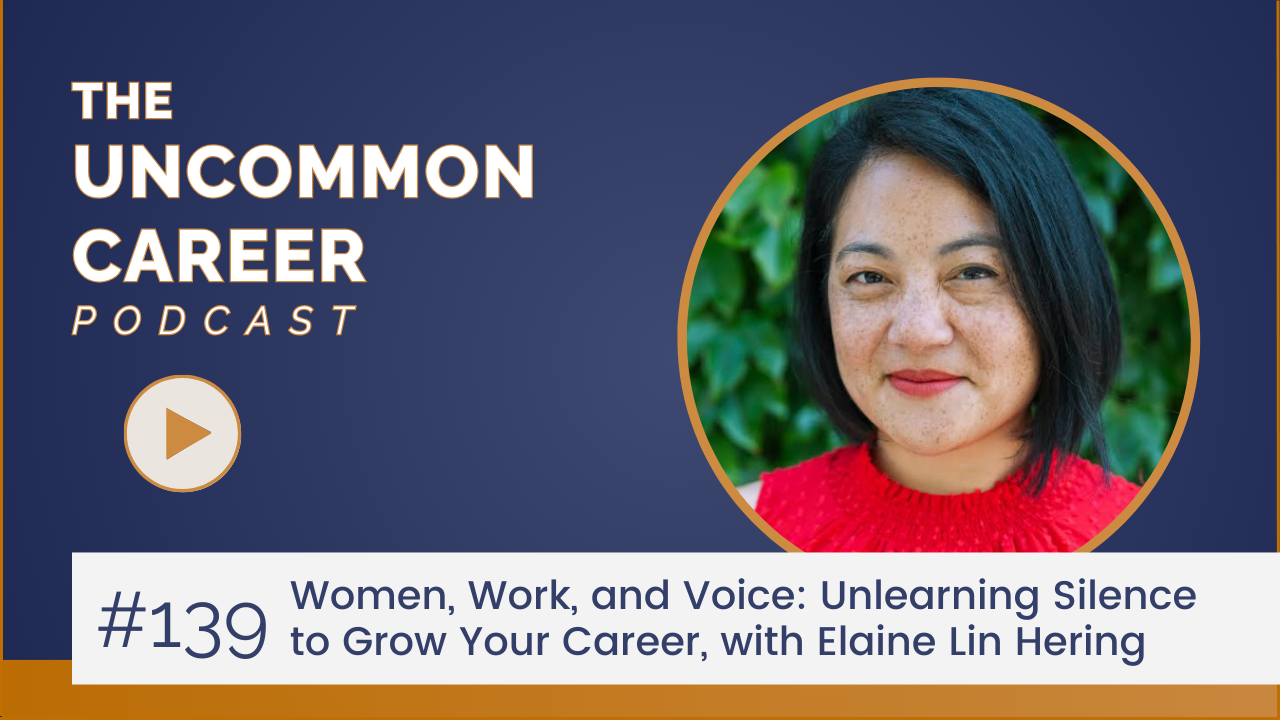79. The Fastest Way to Retarget Your Resume
Oct 01, 2024
Learn a streamlined process to retarget your resume in just 10-15 minutes. Break down steps to quickly adapt your resume to match job descriptions, from identifying key outcomes and skills to reordering bullet points and updating summary statements. Tune in for a systematic approach to ease the job application process, reduce being overwhelmed, and evaluate your career direction.
We'll Talk About
- 00:39 The Fastest Way to Retarget Your Resume
- 01:03 Step-by-Step Resume Retargeting Process
- 03:15 Fine-Tuning Your Resume for Success
- 07:40 Prerequisites for a Successful Resume Retargeting
- 09:04 Creating a Master and Active Resume
- 11:29 Emotional and Mental Benefits of a Streamlined Process
- 12:46 Conclusion and Future Topics
___________________________________________________________________________________
Connect with Me:
-
Connect with me on LinkedIn: https://linkedin.com/in/pmortega
-
Get started with your career move: Download The Career Transition Checklist
CLICK HERE FOR FULL TRANSCRIPT
79. The Fastest Way to Retarget Your Resume
Patricia Ortega: [00:00:00] Hey there, welcome back to the uncommon career. Wouldn't you like to be able to retarget your resume in about 10 minutes flat so you don't feel the overwhelm. You don't feel like you missed something. You have a system, you're ready to go. And when an application comes up or when someone tells you, Hey, we had a great conversation and your experience matches what I'm looking for.
Do me a favor, go ahead and apply tonight and I'll let people know to look for your name. Oftentimes that throws us into a world spin where we're figuring out, Oh my gosh, I've got to overhaul my resume. What do I do? I'm so nervous, right? Here is a process to help you retarget your resume in the fastest way possible.
Okay. First, I'm going to show you how to retarget it, but then at the end of the episode, I'm also going to talk to you about some important prerequisites that help set you up for success. And the reason why this retargeting process is so fast is [00:01:00] because of those prerequisites. So let's get into it.
First thing you're going to do is take just about three to five minutes to read the job description and what you're looking for. Are four things. Number one, you're figuring out the big picture outcome. Imagine the number one reason why it's worth spending the money to hire you. This might be an immediate outcome, meaning you're in sales, for example, maybe there's a really clear way that your position brings value.
I just talked to someone not long ago that they actually do a type of accounting that opens up millions and millions of dollars worth of government contracts. That's a very clear, big picture outcome, but some roles don't have a really big picture outcome that's that clear. But I promise you, there's a reason why they're spending money to hire you, and so you've gotta find out what that is.
Now, this could be making a process easier to enable other people to have that big picture outcome in terms of [00:02:00] making sales, bringing in revenue, et cetera. It might be that the program or the department that you are in is actually building a software that's going to open up another avenue for revenue.
It might be that you're helping the employees to be more productive and therefore opening up more growth. So you want to look at what is the big picture outcome that this role is being hired for. From that big picture outcome, consider one, two, or three KPIs. These are your key performance indicators.
How is your position going to be evaluated? If the goal of the position is that big picture outcome that you've already determined. And finally, you're going to write down the top, the most important, not the tiny nitty gritty, but the most important. Skills, knowledge base, and ability. So KSA skills, knowledge, and abilities, right?
Um, so once you have that, what I personally recommend to do is to put that on a small piece of paper, like a three by five [00:03:00] card, or put that in really big letters on an eight by 11. The reason is because you don't want to have everything in the job description staring at you in the face when you're editing your resume.
So put only what you need on a piece of paper or a three by five card. Armed with this, now you're going to go into your resume and you're going to take just one minute to review and adjust your skills. So your skills is typically a listing, and there's just some key words in there with skills that you have, right?
So what you're going to do is look for words that can be swapped out but mean the same thing. So if one industry names a skill by one term, And this new industry that you're about to apply for names the same skill with a different term, as long as it is still accurate, as long as it is still correct, then you can just swap the word out.
The other thing you can do here is look through the skills and skills that don't seem to be relevant to this job description, go ahead and take them out. And then [00:04:00] add in skills that you have, but maybe didn't put into this resume because you didn't think about it or it just didn't come up. But now they're here in this job description.
Now you want to add those skills. All right. The second thing is take just a couple of minutes. I'm talking two to three minutes. Review your bullets for each position. And you're just going to reorder them. You're literally just going to click and drag the bullet so that the bullets that refer to the big picture outcome, that refer to the key performance indicators or the skills, knowledge, and abilities mentioned in the job description... you want to place those at the very top.
So you're going to reorder those bullets and then reword or swap words as needed. And again, you only want to swap a word here and there just for the sake of keywords, right? to create a moment in the reader's mind that says, ding, they know what we do. So you're just swapping words.
This is not a time to reword. If it's done correctly, you should have very minimal rewording. Alright, the next thing is to tweak your position summary statements in the [00:05:00] same way. These are um, the summary statements for each position are a sentence that encompasses the big picture of what you do in that particular position.
So you want to tweak these to reflect big picture outcomes, maybe a key performance indicator, and maybe you might mention a word or or two related to the skills, knowledge, and abilities. Don't overanalyze this. We can get so stuck on the exact word. Remember we're splitting hairs now. We're just adding a little bit to grab their attention.
So if you feel like you're getting caught up in this portion, I would say, just tweak the summary statement to reflect the big picture outcome and move on. All right. The next one is you're going to spend just a couple of minutes reviewing the highlights. So in your resume on the first page, not everyone, but most people will have a couple of highlights.
So three to five of your most impressive bullets or three to five cumulative accomplishments because some careers [00:06:00] have the possibility of having cumulative accomplishments. Let's say for example, you're in fundraising. If you're in fundraising, you likely have three or four or five different fundraising positions and across all positions, the same major outcome is relevant and this is how much money have you brought in, right?
How many donations or how many donors have made a commitment to your institution and you can add those up across your career and that makes a beautiful highlight. for the front page. So what you're going to do is review your highlights and either adjust the order. So just drag the most important highlight to the top, or you're going to make tiny word adjustments, the same as you did in the bullets and the same as you did in the position summary.
Very rarely will you actually need to go into your resume and bring a different bullet up if it's relevant for the position you're applying to. And then the very last thing you're going to do and the part that I think you should probably spend just a little bit more time [00:07:00] on is on adjusting the summary at the top of your resume to include the big picture outcomes or the big areas that you focus on, right?
In addition to, you know, if you have accomplishments in your summary, which I absolutely recommend that you do, I would encourage you to have those accomplishments reflect key performance indicators. And if you've got space, or if you are able to include a keyword or two that reflects the key skills, knowledge, and abilities.
So with this, it should probably take you, 10 or 15 minutes and you'll get faster and faster as you go. But you do need some important prerequisites, right? There's some setup work that needs to be done in order for you to be able to have a successful, really fast retargeting of your resume. Here's the first one.
Have a clear direction for your career. So before we start anything on a resume, we want to know exactly where we're headed and why. Confirming that that decision [00:08:00] is what is going to benefit and satisfy us both short term. and long term So what specific position is your resume geared towards? What's your branding geared towards?
Otherwise, every time you apply, you're going to feel like you have to overhaul your entire resume. And forget about the resume. The more important piece here is that if you're not sure of your direction, You're going to feel like a leaf in the wind, just constantly being pulled to multiple things. And you won't have a clear story in your mind from which to speak about when they ask you what you do and what you have to offer an organization.
You have to be narrow and focused so that when you speak about what you're interested in doing next, what role you want to take on, you sound confident, you sound focused. And you sound committed to this role and that translates into confidence for the employer that they can trust. This is going to [00:09:00] be a long time hire.
All right. So clear direction for your career. The second prerequisite, once you have a clear direction for your career, is to create a master resume that's optimized for the role that you decided on the industry. In most cases, you will want to focus it on the industry. Some cases it's not quite as important.
So for example, HR, Most HR positions are relatively similar to where you may not need to customize it for the industry as much as you want to customize it for the role. You might even optimize and customize it for the type of organization. So when you do this, most of the expected keywords are already going to be included in your master resume.
Remember that this master resume is going to have way more than you need because it is going to be a complete career history. Every single certificate, professional development event, volunteer opportunity, patent publication, presentation, and more. Everything you [00:10:00] can think of is going to be in this master resume so that you can easily pull from it as needed.
From that master resume, you're going to create a shorter active resume, which is your, you know, one to two, maybe three page resume. And this is focused on the most powerful achievements related to the role you're interested in. So you have the complete resume, just in case you need to pull from it, but then you have the most powerful achievements that are going to make up your one to two pages.
Now, sometimes our master resume is our active resume, right? When you are able to fit all of your experience on one to two pages, we're in good shape just moving on with that one master resume that happens to also be our active resume. This active resume should work for more than half of the roles that you apply to.
Because again, we're really clear on our direction and we're focused on those roles and we're not quite looking at spending time on or applying to other roles because we are niched in to that [00:11:00] one career goal. Now, because this should work for more than half the roles you apply to, the other roles, they should only require minor work.
Because they're in the same area and they just maybe have a different approach or different philosophy or different method of working through the same job. So when you have these things in place, you can then look at a job description, write out your three by five card and start working on the 10 to 15 minutes it takes to retarget your resume.
You're clear headed because you're not feeling like you have to rewrite everything. All You're not rewriting at all. You're just swapping keywords and reordering things and adjusting, maybe not rewriting, but just adjusting your summary. And that's it. That will give you more mental space. It'll give you clarity to focus on what really matters.
It'll give you more emotional capacity. It won't take up so much of this, you know, when we go into the job search, it is an emotional process. [00:12:00] There's ghosting and rejection and there's, you know, what ifs and we get our hopes up about this one position over here and it didn't work out. So now I have to go unmotivated and apply to this other position, right?
So it's a lot of emotion that goes into the process and this way of creating your resume and retargeting your resume. It takes all the friction out of it. So you have a clean cut system and you can move on and apply as needed. So when someone tells you, Hey, I think you'd be a good role for this. Why don't you go and submit your application tonight?
I'll let the leader or the recruiter know that you're going to submit. You don't have to worry. Because you know, awesome. I'll go home, take about 15 minutes and go ahead and submit that. Now you can go about your day and not be nervous about how to overhaul your resume. All right. So I hope this was helpful for you.
Thank you so much for sticking around. Um, in future episodes, we're going to go over the other parts, the prerequisites, right? How to get clear on your career, how to, you know, create that master resume. And [00:13:00] how do you decide what goes on the active resume versus the master resume? All conversations for another day. But for now, know that we love you, we're praying for you, and we'll see you on the next one.












